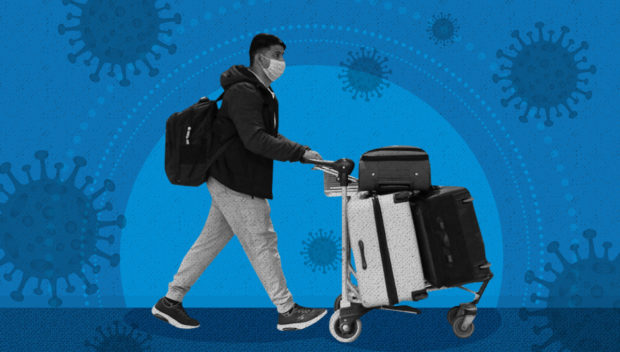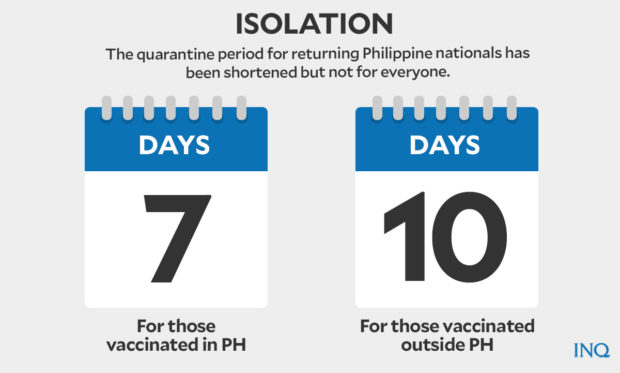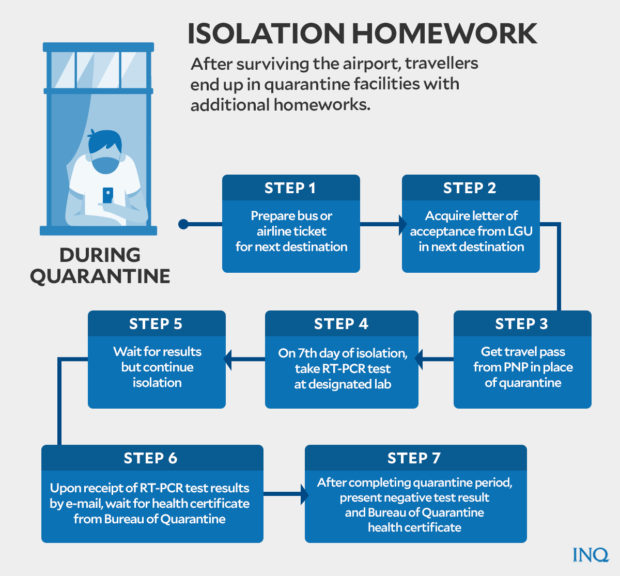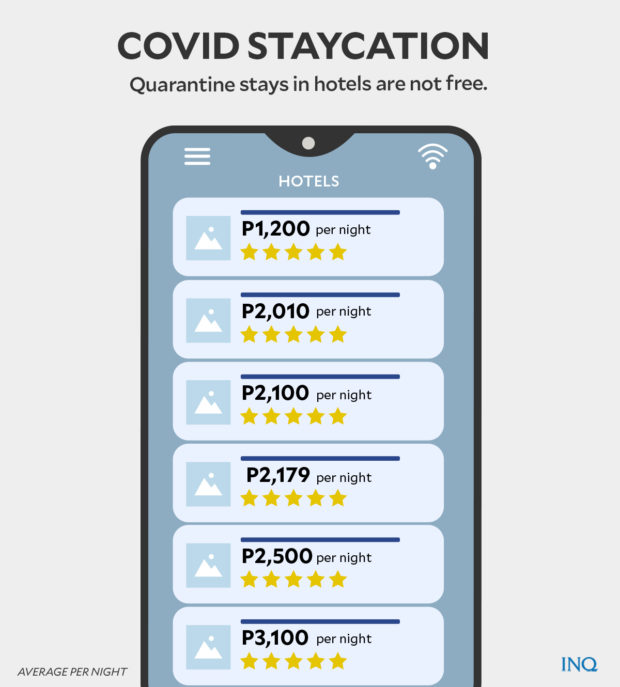Traveling to PH: A clash of convenience, health rules at airports

In the process of enforcing the health protocols, however, passenger convenience or comfort often becomes the price to pay.
While many travelers could be just grinning and bearing it, some turn to social media to complain, like this anonymous social media user, supposedly a balikbayan from the United States, who posted this on Facebook:
“For those abroad, or with relatives abroad, wishing to come to the Philippines, a personal account of someone who just arrived at NAIA from the US:
“It is such a hassle to arrive in the Philippines abroad.
“As soon as plane arrives, we have to wait INSIDE the airplane for a doctor and his staff to check everyone’s temperature and vaccination records. The most STUPID thing is that vaccination from the USA is not considered grounds for a shorter quarantine of 7 days.
“Only vaccination in the Phil can grant you 7 days! I showed the doctor my single Makati Med vaccine shot and 2 Pfizer shots from the US. He has to follow rules daw, even as he understands my position, so, 10 days quarantn!
Article continues after this advertisement“Told him that starting June 16, supposedly vaccinations from abroad would merit 7 days quarantine only. Finally, he gave me 2 email addresses where I can appeal our case for shorter quarantn!
Article continues after this advertisement“Then we had to go down and be ushered in to the airport room where THEY MADE SURE that we PRE-PAY the SWAB test to be conducted on the 7th day!
The social media user mentioned a company as “money-maker” in the arrangement but INQUIRER.net will withhold the company identity unless the author of the post, who remained anonymous, comes out in public with his accusation and substantiates it.
The ordeal, however, is narrated in the rest of the social media user’s FB post:
“Since we are on quarantine, we cannot take outside transpo…So, we asked a hotel for a Sedan or equiv transpo, the cheapest of which cost P2,200. A van costs P3,500.
“They contracted ALL TRANSFERS to an outside company or companies..not from d hotel!
He continued by naming the supposed owner of the transport company that gave them a ride but INQUIRER.net is also withholding the identity unless the social media user who posted the complaint on FB files a case and goes public with it.
But the post continued with what could mirror the complaints of many other passengers:
“Imagine, how sad for those who can hardly afford, even as there are cheap accredited hotels…and imagine how long it would take for all 350 passengers to already prepay the SWAB for the 7th day!
“Kawawa ang mga nasa likod ng plane. Test is 4000 per person but we get senior dsct…we paid 3500 each.
“Good lang that we were one of the first to get out of plane and our luggage was picked up already…The others would have to wait for their luggage after lining up to prepay
“Grabe! Many complaints heard…It will backfire…”
INQUIRER.net studied parts of the post and compared it with current airport protocol and procedures for travelers.
Third dose?
The mention of a third dose by the anonymous complainant deserved a closer look.
So far, all available coronavirus vaccines, except Johnson & Johnson’s Janssen, required only two doses administered days or weeks apart.
In a CNBC interview last April, Pfizer CEO Albert Bourla said people will “likely” need a third or booster dose of the vaccine within 12 months of getting fully vaccinated.
However, in February, the pharmaceutical firm said that it was still conducting clinical trials for a third dose.
The Center for Disease Control and Prevention (CDC) in the United States also explained that additional doses of vaccines are not yet recommended.
“The need for and timing of COVID-19 booster doses has not been established,” said the CDC on its website.
Back home, the Department of Health (DOH) had said that there is no sufficient evidence yet to determine if a third or additional vaccine doses are required.
READ: DOH says more evidence needed for 3rd dose of COVID-19 vaccine
A third dose is not yet being offered or administered in the Philippines and outside the country—except for those who took part in Pfizer-BioNTech’s clinical trial for booster shots.
Quarantine policy
The post also questioned the country’s quarantine guidelines for arriving passengers who have already been fully vaccinated overseas.
On June 4, the government shortened from 10 days to seven days the quarantine period for returning Philippine nationals who had been fully vaccinated in the country.
According to Presidential Spokesperson Harry Roque, the policy took effect starting on June 22.
However, Roque clarified that the new guideline will be only for those who have received vaccines in the Philippines.
READ: 7-day quarantine for returning Filipinos fully vaccinated in PH
“Ten days pa rin pag foreign [national],” Roque told INQUIRER.net when asked to clarify if the shortened quarantine period also covered vaccinated foreigners.
The Philippine Airlines (PAL) also said on its website that “Filipino Nationals and non-Filipinos who received their vaccination outside the Philippines are not eligible for the exemption and reduced mandatory quarantine.”
“Upon check-in, travelers must have their physical vaccination card and a certificate issued by the Department of Information and Communications Technology (DICT) or the City Health Officer of the local government unit which administered the last dose necessary for full vaccination,” the airline company added.
The government has yet to issue a new policy for foreign nationals or Filipinos who were vaccinated abroad.
COVID-19 testing for inbound travelers
Current protocols from the Inter-Agency Task Force for the Management of Emerging Infectious Diseases (IATF) required all inbound passengers, regardless of the country of origin, to take an RT-PCR (reverse transcription-polymerase chain reaction) test on the seventh day of quarantine.
READ: IATF OKs COVID-19 testing for inbound travelers on 7th day of quarantine
“The IATF has approved our recommendation to have a seventh day testing for travelers. There will be no testing upon arrival. The test will be conducted on the seventh day and the travelers should complete 10 days of quarantine at the national level,” said Health Undersecretary Maria Rosario Vergeire at an online press briefing last May.
According to guidelines released by the Department of Foreign Affairs (DFA) non-OFWs (Overseas Filipino Workers), returning OFs (overseas Filipinos), and foreign nationals need to pay for RT-PCR testing which will be conducted at the passengers’ chosen quarantine hotel.
According to PAL, only passengers in those categories are required to pay for the tests.
“The test is free for OFWs, whether they arrive in Manila, Cebu, or Clark, or Laoag,” the airline company said.
Prior to departure from point of origin, passengers should fill up the E-CIF (Electronic Case Investigation Form), which is required by health protocols.
According to the Philippine Red Cross (PRC), this form is important “to minimize the spread of COVID-19 into the Philippines through our ports of entry, It also ensures that anyone arriving into the country will be tested for COVID-19.”
PRC suggested accomplishing the E-CIF at least three days prior to arrival in the Philippines. Those who fail to fill out the form will be barred from passing through immigration, PRC said.
Non-OFWs, returning OFs, and foreign nationals can get the E-CIF provided by PAL.
The RT-PCR test fee is P4,000 which can be paid upon arriving in the country via cash payment using Philippine Peso bills or US Dollar bills, credit or debit card, AliPay, WeChat Pay, GCash, or PayPal.
“You may also pre-pay for your RT-PCR Test. Please follow the instructions indicated in your e-mail after registering to PAL’s electronic Case Investigation Form (e-CIF),” PAL added.
Procedures upon arriving
According to DFA, returning Philippine nationals, who are not OFWs, and foreigners must heed these procedures:
Before the flight or trip
- Passengers are required to accomplish E-CIF before leaving point of origin for a unique QR Code which will be presented to the One Stop Shop (OSS) upon arrival in the Philippines. Terminal 2 PAL passengers can access the E-CIF form through this link (https://bit.ly/MNLPALeCIF) Passengers of foreign airlines passing through Terminal 1 and Terminal 3 can get the E-CIF here (www.padlab.ph/DLS/PassengerCIF)
- The DFA also reminds passengers to pre-book at any quarantine hotel accredited by the Bureau of Quarantine (BOQ) at least seven days before their arrival date.
- Non-OFWs and foreign nationals must also prepare fees for RT-PCR testing and cash for transportation expenses.
Upon arriving at the airport
- Upon arrival, passengers must submit their accomplished Health Declaration Form to the Bureau of Quarantine (BOQ).
- They will then proceed to the area where the Philippine Coast Guard (PSG) will brief them on quarantine protocols.
- The Affidavit of Undertaking will also be distributed there.
- Passengers will next go to the Department of Tourism (DOT) desk to help validate their quarantine hotel facility assignment or accommodation.
- From there, they will transfer to the private laboratory desk where their data will be processed and where they will be asked to pay for the RT-PCR testing.
- The passengers will then proceed to the Bureau of Immigration (BI) for clearance and passport checks.
- After complying with all of the steps above, they can finally claim their luggage.
- Before leaving the airport, passengers must submit their accomplished Affidavit of Undertaking to the PCG.
- Passengers can ride an airport taxi to bring them to their chosen quarantine facility.
During quarantine period
- The DFA suggested that passengers “plan, consider, and prepare” for other requirements while they are on quarantine.
- Passengers must also prepare airline or bus ticket for their next destination.
- Passengers must also secure a letter of acceptance from their local government unit (LGU).
- They must also secure a travel pass from any Philippine National Police (PNP) office at the point of departure.
- On the seventh day, passengers must take the RT-PCR test at the quarantine facility. Strict quarantine protocols must be continuously observed while waiting for test results.
- Upon receipt of negative RT-PCR results via email, passengers must wait for the BOQ health certificate.
- To check out of the quarantine facility, passengers must present their negative test results and the health certificate from BOQ.
The DFA likewise advised passengers not to loiter around and expose themselves to possible transmission after checking out from the quarantine facility.
“Your delay in reporting to your LGU can be a ground for imposition of another 14 days quarantine. Always observe health protocols during your travel,” the department said.
It also suggested completing the 14 days quarantine at the final destination.
According to the website Zenrooms.com, stays at hotels accredited as quarantine facilities would cost the passenger a range of rates per night—P1,200/P2,010/P2,100/P2,179/P2,500/P3,100.
So the cost for a traveler staying in a quarantine hotel would translate to a minimum of P8,400 and a maximum of P21,700 for seven days.
Flight and passenger volume
In 2020, the number of inbound international flights for terminals 1, 2, and 3 reached 9,949, 5,099, and 5,476 respectively.
In the same year the Manila International Airport Authority (MIAA) recorded 978,057, 635,084, and 5,476 international passengers who arrived in the same terminals.
Also in 2020, at least 11,786 flights left for abroad with 12,020,187 passengers through Terminal 1.
In Terminal 2, at least 4,079 flights and 564,458 passengers left for abroad. In Terminal 3, the numbers were 6,092 flights and 1,156,769 passengers.
From January to May 2021, there were 3,661 international flights and 81,875 international passengers that arrived in the country via Terminal 1.
There were also 4,718 international flights and 246,291 passengers that departed through the same terminal during the same time period.
In terminal 2, there were a total of 1,414 international flights and 130,158 passengers that arrived in the country.
Terminal 3 recorded 1,595 international flights and 102,729 passengers who arrived this year. At least 1,863 flights and 247,156 passengers, on the other hand, left the country.
TSB



